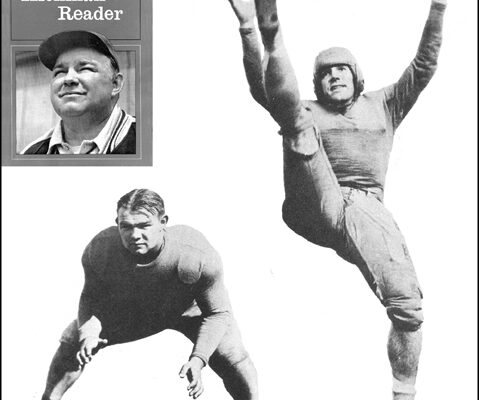Louis Feathers, an occasional contributor to my column, is particularly proud of the fact that he is a fifth cousin to Herman Michael Hickman and William Beattie Feathers, two former University of Tennessee football standouts. Anybody knowledgeable of Big Orange football is familiar with the two names. Louis wrote about them in his 195-page autobiography.

Herman Hickman (left) and Beattie Feathers
Hickman was born on October 1, 1911 in Johnson City. His parents, Herman M. and Ossie Feathers Hickman, lived on W. Unaka and later moved to Highland Avenue. Both athletes played on early 1930s teams that were coached by Robert Neyland for whom the stadium is named. The two of them were on the 1930 squad that won nine games and lost one, remarkably outscoring their opponents 209 to 31. Both athletes were named All-Conference and All-America.
According to Louis, “Hickman was a lineman (guard) who gained fame in sports as well as other fields. He was elected to Phi Beta Kappa and made All-America in his senior year at the age of 19, making him one of the youngest to attain the honor. He played three years for the Brooklyn Dodgers (football) and was a professional wrestler, known as the “Tennessee Terror.”
After serving as an assistant football coach at North Carolina State and Wake Forest, the 300-pound “Friar Tuck” appearing athlete was hired as line coach for Army in the mid 1940s, the days of Glenn Davis and Doc Blanchard (known as Mr. Outside and Mr. Inside). The Army team won three National Championships during this period.
In 1948, Herman became Head Coach at Yale before retiring in 1951. Grantland Rice, a noted sports writer of the time, called him the best guard in football history. Because of his keen intellect and outgoing personality, he became a panelist on “Celebrity Time,” a popular television game show in the 1950s and “The Herman Hickman Show,” a 15-minute sports program. Later, he developed into a public speaker. Louis said he was privileged to hear him speak at a General Electric function in Cincinnati. The football great next turned to writing, which included a column, “Herman’s Hunches,” for Sports Illustrated and a book, The Herman Hickman Reader. The “Terror” died in 1958 at the age of 47.
Feathers next turned the subject to Beattie Feathers who lived in Bristol, Virginia. He played football in an era when team members played both offense and defense. His main position was as a triple-threat halfback, meaning he could run, pass or punt. In 1933, his senior year, he was named All-American. The following year, he joined the Chicago Bears where he became the first NFL player to rush for more than 1,000 yards in a season. He amassed 1,004 yards in 101 carries, averaging nearly 10 yards per carry, while missing two games during the season. In 1938-39, he played for the Brooklyn Dodgers NFL team. A year later, which was his last season, he played for the Green Bay Packers.
Louis further added, “Beattie was later inducted into the National Football Foundation Hall of Fame, which is apparently different from the NFL Hall of Fame at Canton, Ohio. Years later, he coached football and baseball.”
Finally, Feathers commented on the Vol skipper, General Neyland, a 1916 graduate of West Point and career army officer. He came to the University of Tennessee in 1925 as Professor of Military Science and Tactics of the ROTC Unit and also served as the Assistant Coach of the football Team. In 1935, the Army sent him to Panama and a year later he retired from the Army and returned to UT as football coach. Except for the war years, Neyland remained as that position through the 1952 season when he was made Athletic Director at U.T. His overall record at the school was an amazing 173 wins, 31 losses and 12 ties. He had bragging rights to six SEC and four national championships.
A trip to Neyland Stadium is a constant reminder of this great coach from the annals of yesteryear.

Comments are closed.